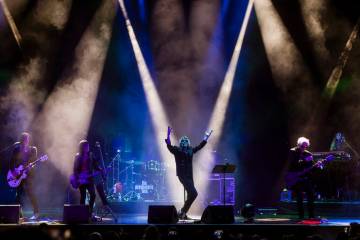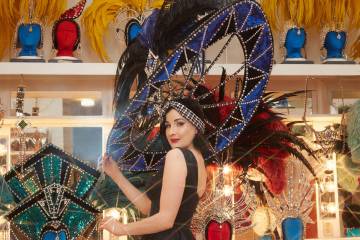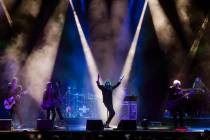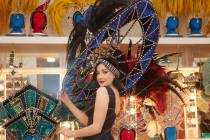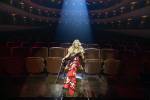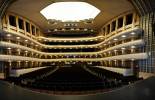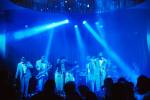New Smith Center packs plenty of ‘wow factor’
This joint -- if you can call a place that cost half a billion bucks a "joint" -- is impressive.
Taken in from the outside, the Smith Center for the Performing Arts is a statement of opulence. Defined by its art deco/Hoover Dam-inspired exterior and its major accent note of Symphony Park, it visually lifts downtown Las Vegas onto its shoulders and carries it forward.
Rising above all its design touches, lush landscaping, sculptures and courtyard to symbolize that is its Carillon Tower. Climbing 17 stories into the downtown sky, it is the center's capstone, housing a four-octave carillon of 47 handcrafted bronze bells -- nearly 30,000 pounds of them -- that will ring with the promise a cultural nexus brings a city.
Surely, with Las Vegas' Strip-full of massive, magnificent hotels that make for eye-popping spectacle and a global playground, the tower is comparatively modest, structurally. Yet for what it represents as a turning point into another level of accomplishment, it stands unmatched.
Though sparkling with surface sophistication that passers-by can absorb, it is the center's previously unseen three performance spaces -- plus the gateway into the largest one -- that will leave visitors with lasting impressions and provide the most memorable experiences.
Thanks to a sneak peek given to the Las Vegas Review-Journal, here's a look into the beating heart of the Smith Center for the Performing Arts:
■ ■ ■
Look up. That trio of massive chandeliers dominating the ceiling and a good deal of available air space? Seventeen feet long from top to tip.
With that, welcome to the grand lobby of -- and elegant entranceway to -- Reynolds Hall, the center's 2,050-seat performance hot spot.
Slowly level your gaze to take in the expanse of the lobby, all 5,000 square feet of it -- from the rich marble floor (Fior di Pesco is the specific style) and marble lining the walls to the majestic, stainless-steel staircase that widens into a balcony embracing and overlooking the lobby.
Staring down at the floor pattern from the 4,000 square-foot upper lobby, beware of dizziness. That handrail is there for a reason.
More than a well-appointed holding pen for patrons to idle before performances and between play acts, the two-tiered Reynolds lobby is its own experience. Flowing in its feel, the design eschews the boxy and rigid atmosphere that marks lobbies of many performance halls, its semicircular layout fostering a social atmosphere. (Go ahead, lower-floor patrons: Hobnob with the box holders.)
Emphasizing an airy vibe, the space features huge windows revealing dramatic views of downtown Las Vegas. Natural light streams through the staircase via skylights and circular twin cupolas, or domelike structures that are open-air, allowing views down to the main lobby (dizziness alert again). Beyond the chandelier behemoths that anchor the ceiling design, other chandeliers and lamps accent the hall. (Note the local pedigree: Though designed in New York, light structures were built by Creative Light Source Inc. of North Las Vegas.)
Further decorating the lobby are designs of the iris, the favorite flower of the late Mary B. Smith, for whom the center is named along with her husband, former Review-Journal executive Fred W. Smith.
Highlighting the lobby is a Benjamin Victor sculpture. Inspired by the Hoover Dam, the winged piece is depicted moving forward, representing progress.
Should you for some reason forget you're at the Smith Center, its logo of architectural lines, inspired by the Hoover Dam's penstock towers, is everywhere: columns, door handles, even carved into the handrails.
Abundant wheelchair access exceeds federal requirements, and the Smith Center has addressed the most vital intermission issue. Forget your fear of 5-mile-long bathroom lines; there are 66 stalls for women and 38 for men.
Lollygagged outside enough?
■ ■ ■
Certainly there's a "wow factor." Reynolds Hall is more an arts arena than a mere hall, a symphony of elegance in brown and beige. Contradictory as it sounds, the horseshoe-shaped venue marries immensity to intimacy, creating a cozy colossus inspired by centers from New York's Carnegie Hall to Milan, Italy's La Scala.
As theater designer Joshua Dachs, president of Fisher Dachs Associates Inc., told the R-J when construction began, stacking the gently curving balconies, rather than staggering them on an upward curve, was crucial to creating a shared experience for the audience.
"If you look around the world at theaters people love to go to, they all have a very compact footprint," he said. "By stacking vertically, everybody gets much closer. If we took the same audience and made it with just one balcony, the room would be twice as long and patrons would be twice as far away, and that would be very damaging to the whole experience."
Using state-of-the-art computer software, Dachs and his designers were able to virtually sit in every seat to gauge sightlines until they were convinced that they provided good visibility. Perhaps the only slightly compromised views are a couple of seats at the extreme corners of the hall, where the first moment of a performer's entrance might be blocked.
Around 90 percent of the seats are fixed, but there is more flexibility in the boxes, where mohair-covered chairs can be shifted around for comfort, as well as making more maneuvering room for wheelchair-bound patrons. Boxes also have private anterooms.
Continuing the Italian marble theme are terrazzo floors, lending a warm, burnished feel. Design flourishes include sawtoothed patterns in the ceiling surfaces, disengaged pilasters on the walls and, notably, the music-inspired paintings of artist Tim Bavington.
They are, however, supporting players to the hall's big visual bang: a ceiling light of five large cascading rings of opal glass set into a silvery metal armature and crowned by a glowing laylight.
Wide, deep and dramatic, the stage is equipped to be reconfigured for different types of performances with a fly tower providing space for sets and curtains ferried in and out during theater productions. Below, a full orchestra pit can hold a hearty 98 musicians.
Built for the Las Vegas Philharmonic -- which is sharing Reynolds Hall as a permanent co-tenant with Nevada Ballet Theatre -- is a "shell" that creates a controlled environment that will prevent sounds from shooting off into space, balance them and allow musicians to better hear each other. Housed in an upstage niche with an 80,000 pound ceiling measuring 60 feet wide and 40 feet deep, it can be lowered in place and secured by 13 wheeled-in wall towers.
Visiting performers are sure to be spoiled here. Defying show-biz tradition that usually relegates show people to airless, basement bandboxes as dressing rooms, Smith accommodations are hotel suites by comparison. Most are set along the street with plantation shutters over frosted glass, allowing the sun to shine through. Inside the "star" dressing rooms, showers, fold-out buffet tables, wall-mounted flat-screen TV monitors and plush furniture join the makeup area to make quarters so comfy that it might take a bit of cajoling to lure performers out and up to the stage.
■ ■ ■
Kindly walk this way as we stroll over to the Boman Pavilion, which houses the smaller of the center's three performing spaces. Emanating a jazzy classiness redolent of the late Bobby Short's legendary dates at New York's Cafe Carlyle, the Cabaret Jazz room could create something similar for local favorite Clint Holmes, who will hold forth there monthly.
Intimacy is the key inside the two-level, 3,800-square-foot Cabaret that accommodates approximately 260 patrons and features table-and-chair seating on its mezzanine level. Performers including Barbara Cook, Branford Marsalis, the SFJAZZ Collective and Andrea Marcovicci will take the stage against a windowed backdrop to expose a vivid panorama of Symphony Park and the downtown area against the neon-lit night sky of Las Vegas.
With no disrespect intended toward the smaller clubs and restaurants that have nobly kept jazz breathing in this city, not since the former Blue Note has that distinctly American but neglected genre had a local home of this caliber, inspired by the Jazz at Lincoln Center program in New York.
U-shaped and radiating warmth, it is an intriguing layout in that the upper level, creating a double-decker viewing area, lends it a sense of minigrandeur rare for most jazz outposts. Atmosphere can match artistry here. Aficionados could argue that it is grittier venues -- basement clubs and little performance nooks tucked into the urban maze in other cities -- that gave jazz its authenticity over the years.
But there will be an undeniable feel here: that blue-light, late-night vibe in which clinking glasses provide their own musicality to accompany the music onstage.
Versatility is the watchword for the Troesh Studio Theater, a 3,000-square-foot space that can entertain up to 240 people and is designed to be redesigned from event to event to fit the needs of performing ensembles or community groups. Large windows can be covered to create a "black box" for smaller theater shows -- including those by children's groups -- and a softer "sprung floor," favored by dancers, was installed to absorb shocks and minimize injuries.
Dedicated patrons of locally produced theater probably will feel that the longtime studio theaters or "black boxes" in town -- at the University of Nevada, Las Vegas, the College of Southern Nevada and Las Vegas Little Theatre -- have a funkier, down-and-dirtier off-Broadway feel when compared to the Troesh. Here, the sense is more pristine as opposed to dark and contained, especially with those sizable windows.
Unlike those other venues, however, Troesh is a multipurpose space, meant for variety and a wider performance palette. Productions come in packages big and small, and this space is the other end of the seesaw from Reynolds Hall.
■ ■ ■
Opulence and artistry intertwine at the Smith Center for the Performing Arts, as glimpsed in this peek of what could represent our cultural peak.
Whether the city responds over time to what it offers is the X factor -- the city of gaming's half-billion-dollar gamble.







